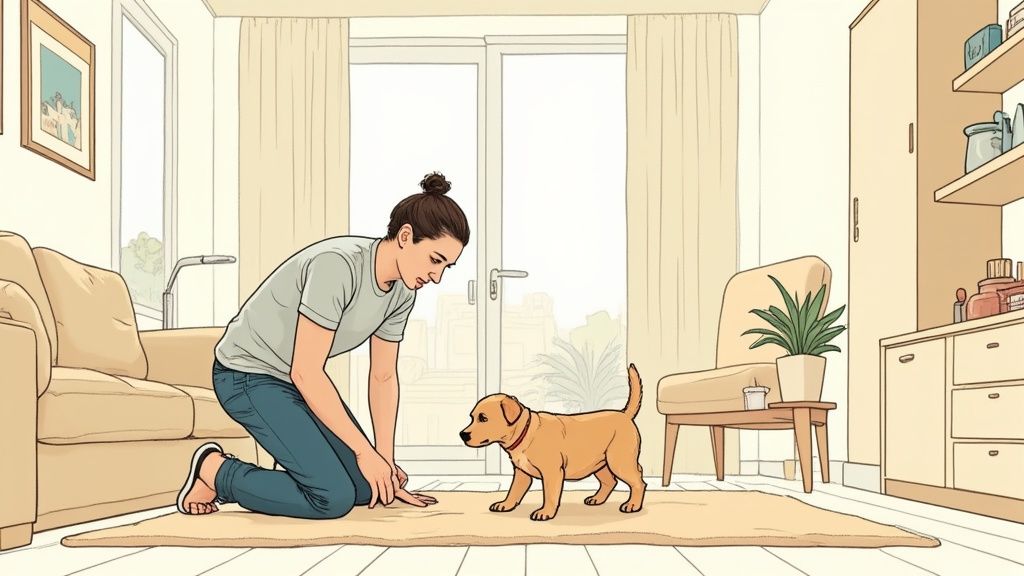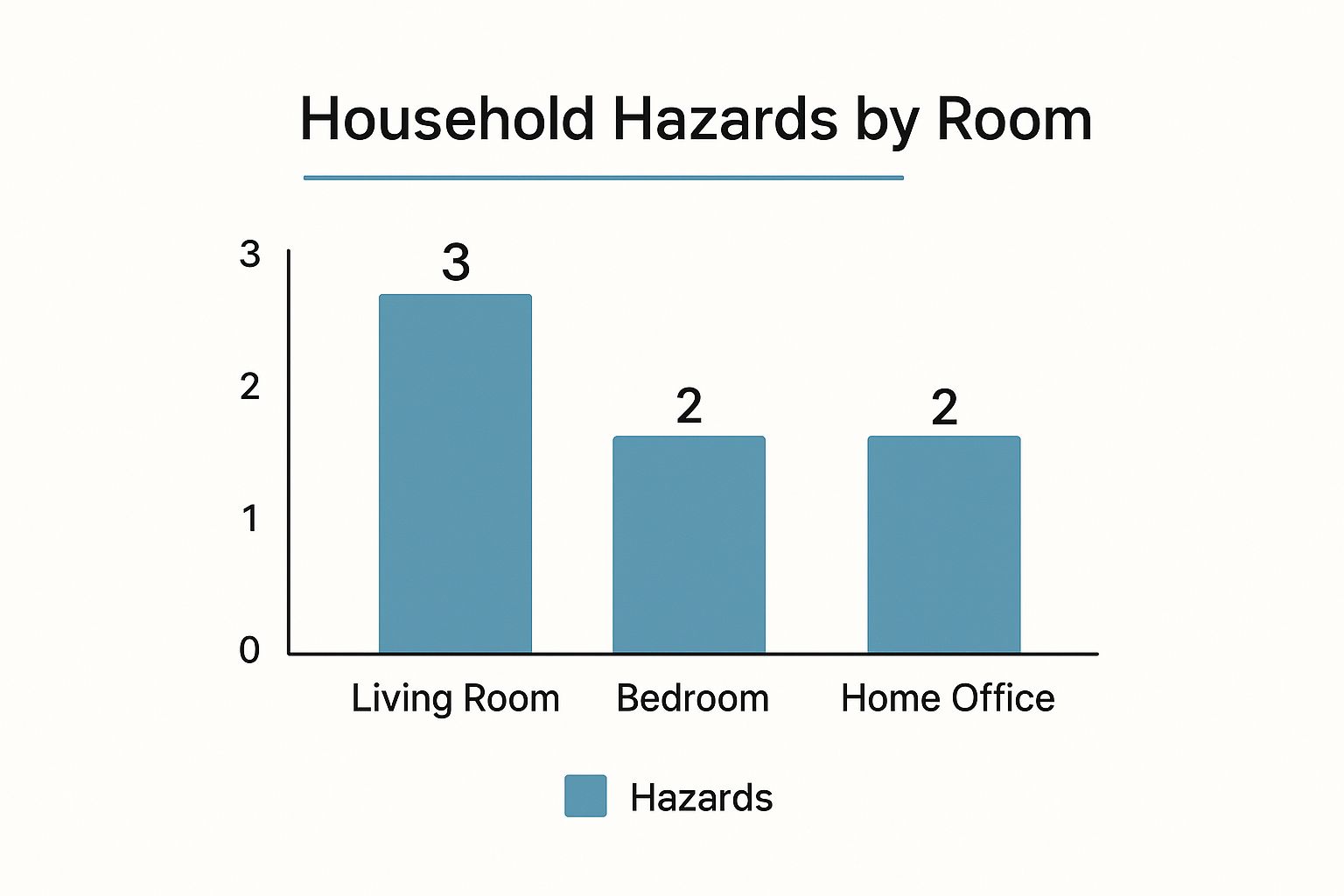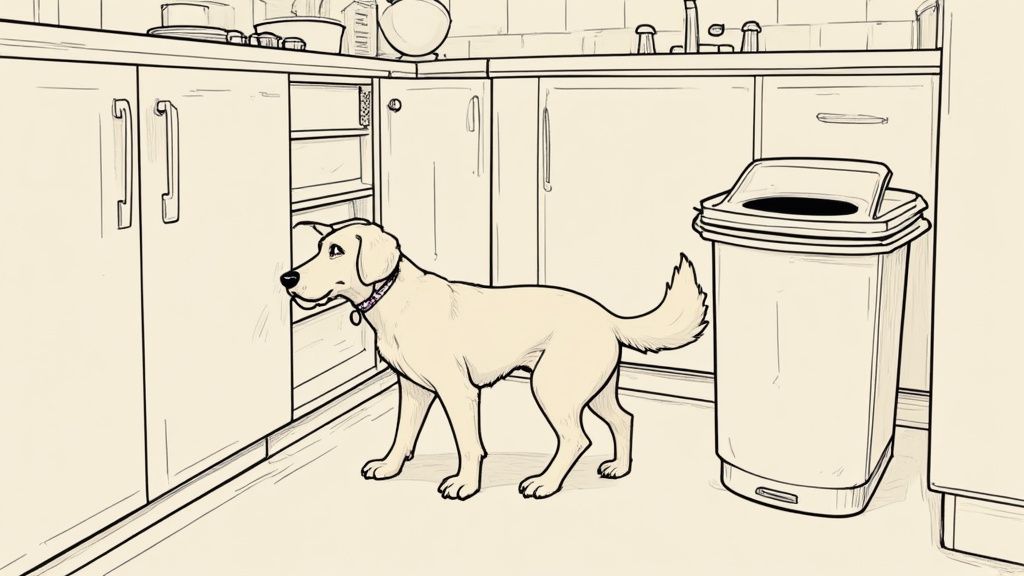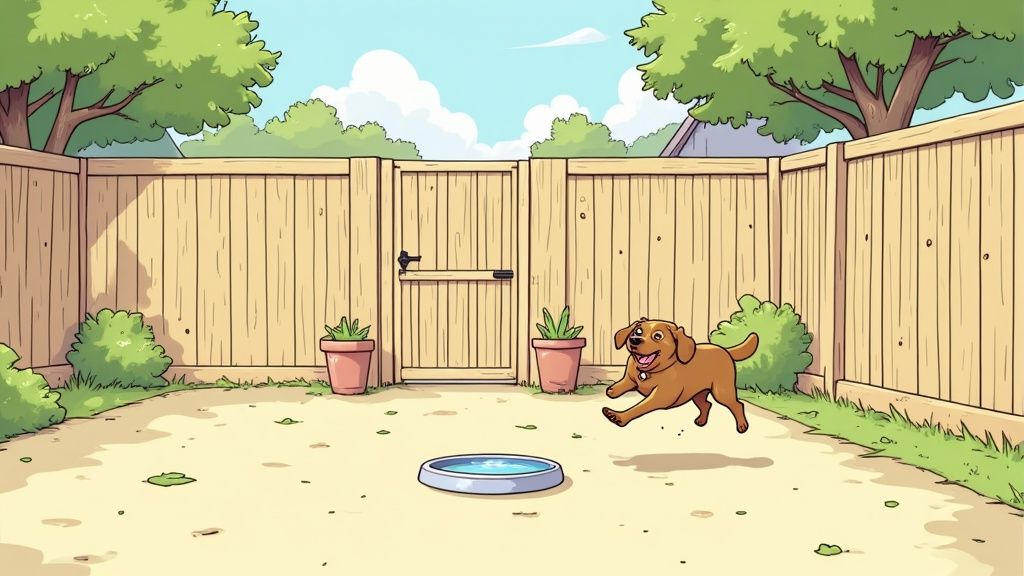A Doggy Daycare Owner's Guide on How to Dog Proof Your Home
- ericavdippold
- Oct 10
- 13 min read
Hi there! As someone who runs a doggy daycare, I've seen it all—the clever escape artists, the professional sock-stealers, and the puppies who believe electrical cords are the best chew toys ever invented. The first thing I always tell new dog parents is this: to truly dog-proof your home, you have to see the world from their level. I mean that literally.
Get down on your hands and knees and crawl around a bit. You’ll be shocked at what you find, from dangling cords to that lost earring under the couch. This simple change in perspective is, without a doubt, the best way to start creating a truly safe space for your new best friend.
Seeing Your Home Through Your Dog's Eyes

Bringing a new dog home is one of the best feelings in the world. After years in this business, I've been lucky enough to see hundreds of those "welcome home" moments, and they never get old. My first piece of advice is always the same: remember that your home is an incredible, unknown universe to them, overflowing with new smells, textures, and things that just beg to be chewed.
Our goal isn't to strip your home of all its personality and turn it into a sterile box. It's about creating a secure, loving environment where your dog's natural curiosity won't lead them into trouble. It's about giving you both peace of mind.
A dog explores with its mouth the way we explore with our hands. Once you get that, you start seeing potential dangers everywhere.
Start Small, Stay Safe
I'll never forget a clever beagle at my daycare named Buster. We thought we had the supply room completely locked down, but he figured out how to nudge a slightly ajar door open with his nose, pull out a single sneaker, and parade it around like a trophy. Thankfully, he was just proud, not destructive! It was a funny but powerful reminder: dogs are incredibly persistent and resourceful.
That experience taught me the most crucial first step in dog-proofing: control the environment from day one.
A great way to do this is by using dog gates to manage their space. By gating off a single "safe" room or a small area, you dramatically reduce the number of hazards they can get into. This is especially vital for clumsy, curious puppies who could easily take a tumble down a flight of stairs. For more tips on this, PetMD.com offers some great advice on puppy-proofing.
By starting with a smaller, controlled area, you build a foundation of safety and can gradually introduce your dog to the rest of their amazing new home.
Your Room-by-Room Dog-Proofing Checklist
Alright, let's get down to business. The best way to tackle dog-proofing without feeling completely overwhelmed is to go room by room. It’s a systematic approach that makes sure you don’t miss any of those sneaky, hidden dangers.
We'll start where you and your new pal will probably be spending most of your time.
The Living Room Lowdown
Your living room is ground zero for adventure, which means it’s also ground zero for potential hazards. It’s full of interesting smells, fun textures, and a surprising number of things that a dog will find irresistible. Trust me, I've seen pups at my daycare proudly trot out with everything from a TV remote to a stray sock. Let's get ahead of that.
The biggest culprits in here are usually the things we humans barely even notice.
Electrical Cords: To a curious dog, that tangled mess of wires behind the TV looks like the world's best chew toy. But a single bite can lead to a serious, even fatal, electrical shock. The goal is to get them out of sight and out of mind. Grab some pet-safe cord concealers that stick to the baseboard or tuck all wires securely behind heavy furniture your dog can’t move.
Toxic Houseplants: Oh, this one's a biggie. So many common houseplants are toxic to dogs. Popular varieties like lilies, Sago Palms, and tulips can cause anything from an upset stomach to life-threatening organ damage if your dog decides to snack on them. For a deeper dive, it’s worth reading up on why some flowers like Easter Lilies are especially dangerous for dogs.
Small, Tempting Objects: This is where you have to get on your hands and knees and see the world from their perspective. Check under the couch, behind the cushions, and beneath chairs. You’re looking for dropped coins, buttons, batteries from the remote, or small kids' toys—all of which are major choking hazards.
Bedroom and Home Office Safety Sweep
Next up are the more personal spaces, which come with their own unique temptations. A dog's logic is pretty simple: if it smells like their favorite person, it must be fun to chew on.
Shoes are a prime target in the bedroom. They’re soaked in your scent, which is both comforting and apparently delicious to a dog. Instead of leaving them by the door, make it a habit to put them away in a closed closet or on a shoe rack well out of reach.
The laundry hamper is another classic trouble spot. To a dog, your dirty laundry is a treasure trove of fascinating smells. Investing in a sturdy hamper with a heavy lid is a smart move. It can prevent your dog from swallowing socks or other clothing, which can lead to a very dangerous—and expensive—intestinal blockage.
In the home office, modern gadgets introduce new risks. Even when it’s turned off, a paper shredder can be a hazard for a curious nose. Make it a rule to unplug it completely when you’re not actively using it.
This quick visual breaks down some of the common household hazards we just covered.

As you can see, the living room is often the hotspot for everyday items that pose a risk to our furry friends.
By methodically checking these areas, you're not just tidying up—you're creating a safe environment where your dog can truly relax and be themselves. This proactive approach gives them the freedom to explore and gives you invaluable peace of mind.
Remember, a little prevention is worth a pound of cure, and it saves everyone a lot of stress. Up next, we'll dive into the kitchen and bathroom, two rooms that need some special attention.
Navigating Kitchens and Bathrooms Safely

If I had to pick the two rooms where dogs get into the most trouble, it would be the kitchen and the bathroom, hands down. Over the years, I've heard stories that would make you both laugh and cringe! For a curious dog, these areas are a five-star buffet of tantalizing smells and fascinating objects.
A little extra attention here is one of the most important parts of learning how to dog proof your home. It's where some of the most serious dangers are kept, often right at nose level.
Securing the Kitchen
The kitchen is the heart of the home, but it’s also a minefield of potential hazards. From dropped food to open trash cans, the opportunities for mischief are endless.
A determined dog can knock over a flimsy trash can in seconds, giving them access to old food scraps, sharp objects, and toxic materials. Investing in a heavy, tall trash can with a locking lid is non-negotiable. I always recommend models with a sturdy step-pedal that are too heavy for even a big dog to tip over.
Next, get down on your dog’s level and look at your lower cabinets. These are prime spots for storing cleaning supplies, which are incredibly dangerous if ingested. A simple and inexpensive fix is to install childproof latches on any cabinet doors within your dog's reach. They're a breeze to install and create a barrier that most dogs just can't figure out.
A dog’s sense of smell is up to 100,000 times more powerful than ours. That leftover chicken in the trash or the sweet-smelling cleaner under the sink is impossible for them to ignore. Out of sight and securely locked away is the only truly safe approach.
The Problem with People Food
So many of the foods we love are outright toxic to dogs. A moment of carelessness, like leaving a bowl of grapes on the coffee table or dropping an onion on the floor during meal prep, can quickly turn into an emergency vet visit.
Here are some of the most common kitchen culprits to keep secured:
Xylitol: This artificial sweetener is lurking in some peanut butters, gum, candy, and baked goods. It is extremely toxic and can cause a rapid, life-threatening drop in blood sugar.
Grapes and Raisins: Even a small amount can cause sudden kidney failure in dogs.
Chocolate, Coffee, and Caffeine: These contain substances that are poisonous to dogs, seriously affecting their heart and nervous system.
Onions, Garlic, and Chives: These can damage a dog's red blood cells, which can lead to anemia.
Always keep these items stored on high shelves or in a pantry that your dog absolutely cannot access. It’s a simple habit that prevents a world of worry.
Bathroom Hazard Patrol
The bathroom presents its own unique set of dangers, starting with the medicine cabinet. Many common human medications—both prescription and over-the-counter—can be fatal to dogs. Toxic substances found in kitchens and bathrooms account for a shocking number of canine poisonings, making these areas critical to secure.
To help you get started, here's a quick look at some of the biggest offenders you'll find in these rooms.
Common Household Toxins for Dogs
Item | Location | Potential Danger |
|---|---|---|
Cleaning Products | Kitchen, Bathroom | Bleach, ammonia, and other chemicals can cause severe internal and external burns. |
Human Medications | Bathroom, Kitchen | Pain relievers (ibuprofen, acetaminophen), antidepressants, and other drugs can cause organ failure. |
Xylitol | Kitchen | This sweetener is found in some toothpaste, gum, and foods. It is highly toxic and can be fatal. |
Onions & Garlic | Kitchen | Toxic to red blood cells, which can lead to anemia. |
Grapes & Raisins | Kitchen | Can cause acute kidney failure. |
Antifreeze | Garage, Bathroom | Ethylene glycol is sweet-tasting but extremely poisonous, causing kidney failure. |
Securing these items is a non-negotiable first step. Always store medications and cleaning products on high shelves or in cabinets fortified with childproof latches. You can discover more insights about keeping your pet safe from household toxins on ZoetisPetcare.com.
Even everyday toiletries like toothpaste, lotions, and soaps can cause serious stomach upset if your dog decides to sample them. Keep them tucked away in drawers or high up on a shelf.
And finally, a simple but often forgotten tip: keep the toilet lid down. Dogs are often drawn to drink from the toilet bowl, which can expose them to harmful bacteria and chemical residues from toilet cleaners. It's an easy habit to get into that keeps them much safer.
Securing Your Outdoor Space for Safe Play

A safe home for your dog doesn't stop at the back door. Your yard should be their personal playground—a place to chase balls, sunbathe, and just be a dog. At my daycare, I see the pure joy dogs get from having a secure outdoor space to just let loose. Creating that same kind of haven at home is one of the best things you can do for your pup and your own peace of mind.
Making your yard escape-proof is a critical part of learning how to dog proof your home. It's all about building a fortress of fun where your dog can be free, and you can finally relax, knowing they're protected from hidden dangers.
Building a Better Boundary
Your first line of defense is always a good fence, but I’ve seen firsthand that not all fences are created equal. You need a fence that’s right for your dog's size, breed, and athletic prowess. For most medium to large dogs, a fence that's at least 5 to 6 feet tall is a solid starting point to prevent any acrobatic escapes. For a deeper dive, the folks at MyPet.com have some excellent backyard safety tips.
But a tall fence isn't enough. I make it a habit to walk my fence line regularly, and you should too. Keep an eye out for loose boards, rust, and especially any gaps at the bottom. A determined digger can exploit a tiny opening and be gone in minutes.
A secure fence isn't just about keeping your dog in; it's also about keeping potential dangers, like stray animals, out. Think of it as your dog's personal bubble of safety.
If you've got a digger on your hands, burying chicken wire about a foot deep along the base of the fence is a great deterrent. Placing large, flat rocks there works well, too. For those who own a true escape artist, our guide on how to keep your furry friend safe from running away has some more advanced strategies.
Eliminating Common Yard Hazards
Once your perimeter is locked down, it’s time to sweep the area for hidden dangers. Get down on your dog's level and look around—it’s amazing what you’ll spot.
Toxic Plants and Landscaping: So many common garden plants are surprisingly toxic to dogs. Things like azaleas, rhododendrons, and many types of lilies can cause serious harm. Take an inventory of your garden and either remove the dangerous plants or securely fence them off. Oh, and steer clear of cocoa mulch; it smells irresistible to dogs but is highly toxic.
Lawn and Garden Chemicals: Fertilizers, pesticides, and weed killers are huge red flags. Make sure they are stored securely in a locked shed or high on a shelf your dog can't possibly reach. After treating your lawn, always follow the product’s instructions for how long to keep pets away.
Essential Comforts: This one is simple but often overlooked. Your dog needs easy access to a shady spot and plenty of fresh, cool water whenever they're outside, especially on warm days. A covered patio, a big shady tree, or even a doghouse can make a world of difference.
The Ultimate Safety Net
Even with the most secure yard, the unexpected can happen. That's why a microchip is your ultimate backup plan. It’s a fact: dogs with microchips are 2.4 times more likely to be returned to their families if they ever get lost.
It’s a quick, inexpensive procedure that gives your dog a permanent form of ID. It just might be the one thing that brings your best friend home safely.
Training Is Your Best Defense
You can install all the gates and cabinet locks you want, but those are just physical failsafes. The real secret to a dog-proof home is creating a partnership with your dog. It's all about teaching them how to make good choices, even when a gate isn't closed or you accidentally leave a cupboard open.
I see it every day at my daycare: a well-trained dog is a safe dog. Basic commands are more than just party tricks; they can literally save your dog's life. The single most important command, in my opinion, is a rock-solid "leave it." This is your first line of defense against everything from a dropped piece of chocolate to a tempting-but-toxic mushroom on your lawn. It stops a potential disaster before it even begins.
Of course, no one's perfect. For those times when your dog is just a little too quick, a reliable "drop it" is your essential backup plan. Through consistent and positive training, you build a clear line of communication that keeps your home safe and your mind at ease.
Work With Their Instincts, Not Against Them
Let's be real: dogs explore the world with their mouths, especially when they're young. Chewing is a perfectly normal, healthy instinct. Our job isn't to stop them from chewing, but to teach them what they're allowed to chew on. This is where redirection becomes your most powerful tool.
The moment you see your puppy making a beeline for a chair leg or your favorite sneakers, don't just yell "No!" Instead, grab a high-value chew toy or a fun puzzle feeder and excitedly offer it as a trade. You're teaching a simple, positive lesson: "You can't have that, but you can have this awesome thing instead!"
A tired dog is a happy (and less destructive) dog. Never underestimate the power of mental and physical exercise to prevent chewing and other problem behaviors.
A long walk, a vigorous game of fetch, or a tricky food puzzle can drain that restless energy that so often fuels mischief. If you've noticed sudden or worrying shifts in your dog's behavior, it's worth taking a deeper dive into understanding dog behavior changes and their causes.
Your Strategy Has to Evolve
Remember, dog-proofing isn't something you do once and then forget about. Your approach has to grow and change right along with your dog.
The Puppy Stage: Think of this as maximum-security mode. Their curiosity is at an all-time high, but their understanding of the rules is basically zero.
The Adolescent Stage: Get ready for boundary-testing. They know the rules, but they'll push to see what they can get away with. Consistency is everything here.
The Adult Stage: By now, you know their quirks and personality. You can probably relax a little, but you should never become complacent.
The Senior Stage: New challenges can emerge as their mobility, hearing, or eyesight changes. Stairs can become a hazard, or they might not hear you coming up behind them.
This constant process of observing, training, and adapting is what truly transforms a house into a safe and loving home for your best friend.
Your Dog-Proofing Questions Answered
After years of running my doggy daycare, I've heard just about every question you can imagine when it comes to keeping a pup safe at home. New dog parents often worry about the same things, so I wanted to wrap up with some quick, straightforward answers to the questions I get asked the most.
Think of this as our little chat over the fence—just some practical advice from one dog lover to another.
What Should I Do If My Dog Eats Something Toxic?
First, and most importantly, stay calm. Your dog will pick up on your panic, so take a deep breath. Immediately call your veterinarian or the Pet Poison Helpline at (855) 764-7661. Have a pen ready to write down their instructions.
Do not try to make your dog vomit unless a veterinary professional explicitly tells you to. Some substances can cause even more damage coming back up. If you can, safely identify what your dog ate, how much they consumed, and roughly when it happened. This information is absolutely critical for the vet to give you the best advice.
How Can I Dog-Proof a Small Apartment?
Dog-proofing a smaller space or a rental is totally manageable! The key is to think vertically. Use tall shelving to get plants, decor, and other tempting items well out of your dog's reach. Instead of drilling holes you'll have to patch later, use adhesive cord concealers that stick right to the baseboards to manage wires.
For blocking off no-go zones, like the kitchen while you're cooking, a pressure-mounted, heavy-duty baby gate is your best friend. It’s sturdy, effective, and won’t damage the door frames. Most of the best dog-proofing tricks are temporary and won’t affect your security deposit.
The goal in any space, big or small, is the same: manage their environment to prevent bad habits before they even start. It’s about setting them up for success.
Are There Any Dog-Safe Cleaning Products?
Absolutely! This is one of my favorite easy swaps for a safer home. Look for cleaners that are plant-based and specifically labeled as pet-safe. You'll want to avoid products that contain harsh chemicals like ammonia, bleach, chlorine, or phthalates.
Honestly, one of the best and cheapest all-purpose cleaners is a simple solution of equal parts white vinegar and water in a spray bottle. It's a fantastic, non-toxic cleaner that's perfectly safe for your pets once it dries. It’s what we use for quick cleanups at the daycare all the time—simple, effective, and gives you complete peace of mind.
I hope this guide has left you feeling confident and ready to create a safe, happy home for your new best friend. If you're ever in need of a loving place for your dog to stay and play, the team at Pawcation would be thrilled to meet them! Learn more about our doggy daycare and boarding services.
Comments